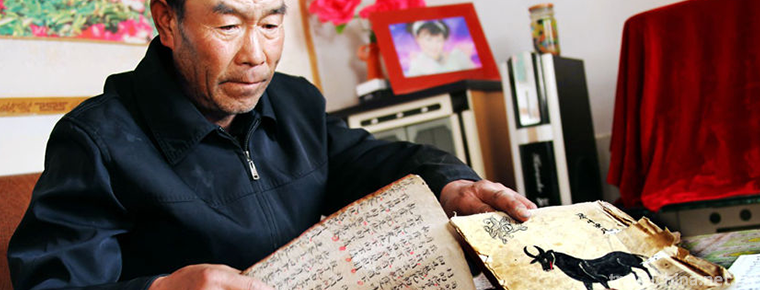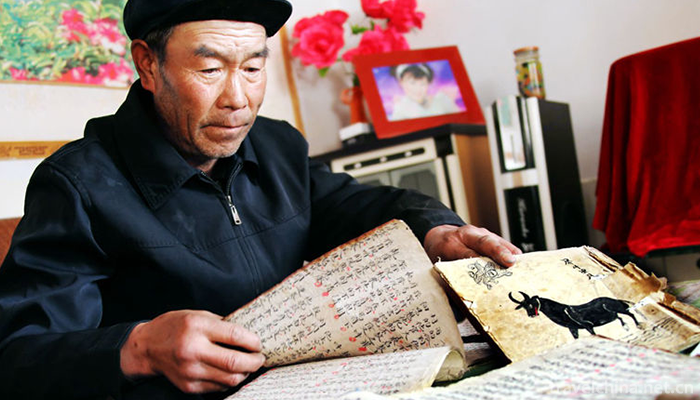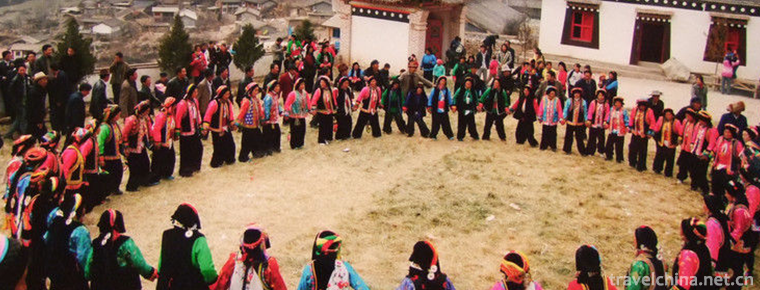2019-02-21

- By ChinaWiki.net
- Chinese Edition
- 2019-05-03
Hexi treasure roll
Hexi Baojuan, a traditional folk literature in Liangzhou District of Wuwei City and Suzhou District of Jiuquan City, Gansu Province, is one of the national intangible cultural heritages.
Hexi Baojuan is a popular literature sung by the folk on the basis of Dunhuang Bianwen in Tang Dynasty, folklore and Song Dynasty classics. The structure of Dunhuang Buddhist Sutras is mainly absorbed and inherited by the Bianwen, vulgar speaking and speaking sutras, while Hexi Baojuan further nationalizes, localizes and popularizes it while inheriting it, making it a form of Chinese folk singing and speaking literature.
On May 20, 2006, Hexi Baojuan was approved by the State Council of the People's Republic of China to be included in the first batch of national intangible cultural heritage lists.
historical origin
Originating from Bianwen Theory
For the origin of Hexi Baojuan, most local researchers in Gansu believe that Dunhuang Bianwen is the mother of Hexi Baojuan. As early as the 1980s and 1990s, this argument was almost conclusive. Xie Shengbao contrasted the variants with Baojuan from four aspects: style, music, singing ceremony and religious thought, confirming Mr. Zheng Zhenduo's conclusion that Baojuan is the descendant of Changwen. Duan Ping believes that Baojuan is the descendant of the variant. Fangbu emphasizes that Hexi Baojuan is a branch of Dunhuang popular literature and a living Dunhuang popular literature. Since then, local researchers have mostly followed this statement.
Originating from Religion
Mr. Che Xilun negated Mr. Zheng Zhenduo's conclusion that Baojuan was the direct descendant of Bianwen when he studied the origin of Baojuan. In his research on the spread of folk religious and sectarian Baojuan (Jingjuan) in Gansu Province, he proved that the folk and Baojuan in Hexi area had the same origin as those in the mainland, especially in the north. In the Ming Dynasty, Wuwei Religion's "Selling and Releasing Vacuum Volume" was introduced to Ningxia in the eastern part of Gansu Province. In the thirty-seventh year of Kangxi (1698), Zhangye printed the "Enclosure of Pingfeng Tianxian Gu Volume". These two kinds of religious volumes prove that from Wanli in Ming Dynasty to Kangxi in Qing Dynasty, with the introduction of folk religions into Hexi Gansu Province, they developed. Folk sects played a very important role in the origin and dissemination of Hexi Baojuan. "In the Qing Dynasty, the folk sects in Hexi were not suppressed by the Qing government. There are still some folk church activities in modern Hexi area, such as the tea party, Baila Club, Huangji Club, Yuhua Club and Mahayana Club in Jiuquan area. They all sponsor or organize the roll reading activities.
Originating from the Northern Treasure Volume
In addition to the influence of folk religions on Hexi Baojuan, the homologous relationship between Hexi Baojuan and Northern Baojuan can also be proved by the existence of a large number of common volumes between Hexi Baojuan and other northern Baojuan. Mr. Che Xilun, after comparing "Shanxi popular folk treasure roll" with "Gansu Hexi popular copy folk treasure roll", believes that Hexi treasure roll belongs to the same system as northern folk roll roll roll roll roll roll roll roll roll roll roll roll roll roll roll roll roll roll roll roll roll roll roll One third of the entries are circulated in other parts of the country. Mr. Che's conclusion is based on rigorous data analysis.
Inheritance and protection
Inheritance value
Hexi Baojuan reflects the people's personal social life, some fables also condemn disobedience, exhort filial piety, hide evil and praise good. Popular as it is, the treasure scrolls are based on the hearts of the people's joys, sorrows and sorrows.
Liangzhou Baojuan was developed under the profound influence of Dunhuang popular literature. The study of Hexi Baojuan can be helpful to the study of Dunhuang. The spirit of persuading people to be kind and helping others to be happy in Baojuan plays an important role in cultivating people's good morality and promoting the construction of spiritual civilization.
Inheritance status
As of 2018, because of the development of rural economy and the change of living customs, few of the candidates of Hexi Baojuan have taken the initiative to hold the activities of chanting Baojuan. Nowadays, most of the candidates are over 70 years old. With the gradual disappearance of this group in the future, Hexi Baojuan will face the crisis of extinction.
Inheritance mode
There are actually two kinds of inheritance of Hexi Baojuan: one is the inheritance of text, the other is the inheritance of performance. Text and performance have their own independence, so there are often differences in the nature of the treasure roll. From the text alone, they are often regarded as folk literature, and from the performance of reading the roll, they are regarded as the art of rap and singing. When the scroll reading activities disappeared, the text of the scroll can still be circulated independently. At present, most of the scrolls handed down are actually only text without performance. From the perspective of text inheritance, Hexi Baojuan is still relatively well preserved, because of the particularity of geographical location, Hexi's reading activities have always existed, and the volume has been re-copied. Compared with the inheritance of text, the inheritance of performance seems more important. There are two attitudes about whether the Hexi scroll can be inherited. One thought it was impossible to pass on.
Inheriting characters
Qiao Yuan, male, Han nationality, born in Jiuquan, Gansu Province in 1944. On May 20, 2006, Qiao Yuan was selected as the representative successor of the first batch of national intangible cultural heritage projects and declared in Suzhou District, Jiuquan City, Gansu Province. Declaration items: Hexi Baojuan.
Li Zuozhi, selected as the representative successor of the third batch of national intangible cultural heritage projects, declared in Liangzhou District, Wuwei City, Gansu Province. Declaration items: Hexi Baojuan.
protective measures
The Jiuquan government's policy of protecting Hexi Baojuan is "extensive census, in-depth excavation and comprehensive collection". To this end, it has formulated measures of "summarizing, collating, scientific research, publishing" and "discovering and training publicists". Specifically, first, conduct extensive census in 18 townships and 164 administrative villages in the whole region to understand the scattering and publicity of the volumes among the people, to master the number and types of the volumes, the number and audience of the volumes. On-site organization of publicity and audition activities, and on-site shooting, video recording, recording. By means of shooting, copying, copying and acquisition, the original volume-suiting scripts and related graphic materials were collected comprehensively.
Secondly, the collected scripts are classified, compared, corrected, refined and carefully screened. On the basis of scientific research and careful sorting out, we will compile and publish a healthy, artistic, easy-to-understand, readable and educational volume. The pictures and texts taken and collected on the spot are edited and recorded by multimedia. They are made into compact discs with abundant pictures and texts, which are easy to preserve and collect permanently, and are matched with the published volumes.
Thirdly, we should find and train a group of publicizers, and allocate some funds to make necessary subsidies for rural publicizing and listening activities, mobilize their enthusiasm and creativity, and constantly improve the level of publicizing and the ability to organize listening comprehension.
Finishing research
According to the survey, there are about 30 volumes of Liangzhou Baojuan scripts, most of which are wooden stereotypes and manuscripts, and some mimeographs appeared in the early 1980s. Jiuquan Baojuan has collected more than 70 pieces of ci-poems, tunes and singing tunes, and the number of Baojuan has reached more than 70 (including catalogues) and more than 140 copies.
social influence
Important activities
On the afternoon of May 6, 2017, Zhangye City Moshang Book Club and Shengshi Classic Culture Company jointly held the 37th offline event with the theme of "Hexi Baojuan Protection and Inheritance" in Liujiayuan, Ganzhou City. The activities involved the introduction of knowledge about ancient dwellings, Memorial singing of treasure rolls, performances of social fire plaster melodies and so on. Among them, the most commendable one is the teaching and singing of Baojuan. The inheritor, Master Guo Yongshou, taught and sang a passage in The Story of Baojuan Red Box in Hexi, using the song card "Playing Lotus Flower".
From August 16 to 17, 2018, the 19th Academic Conference of the International Asian Folklore Society and the Academic Seminar on Silk Road Folklore and Ganzhou Ancient Music Inheritance were held in Hexi Folklore Expo Park, Linze County. The seminar focused on such research topics as the blending of Hexi Baojuan and Silk Road's multiculturalism, the non-heritage protection and the living inheritance of Hexi Baojuan, and the mutual penetration of ancient music and Chinese culture in Hexi Corridor. The experts and scholars attended the seminar conducted in-depth discussions and exchanges.

Ask a Question
Your email address will not be published.



0 Questions